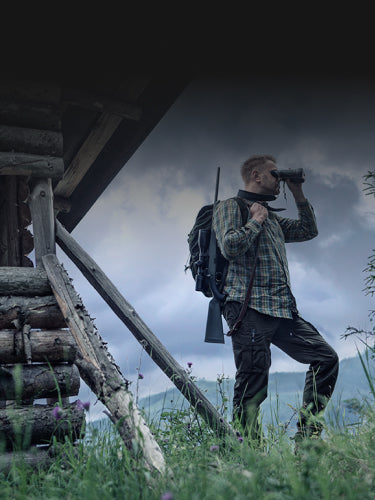Growing up on a farm, I know firsthand how problematic coyotes can be. Not only do they pose a threat to young cattle, but they also kill young deer. For these reasons, I take it upon myself to hunt them as often as I can. In a land where farmland stretches for miles, after every sunset, the night air is pierced by the eerie calls of coyotes.
Aiming to set ourselves up for success, both my brother Micah and I chose to use bolt-action rifles for making more precise shots at a distance. While I use a Seekins Precision HAVAK HIT Pro topped with the Pulsar Thermion 2 LRF XG50, he uses a Christensen Arms MPR topped with the Pulsar Thermion 2 LRF XP50 Pro. Not only are these rifles capable of precise shots, but they are also equipped with thermals that have been updated to use an integrated ballistics calculator. Pulsar recently released this update, and I have been eager for it for years.
To use the onboard ballistics calculator, all you have to do is upload your rifle's ballistics data into the app, and then the scope can calculate the elevation holdover needed for long-range shots. Once all this data is uploaded to the scope, simply enable the ballistic calculator, press the rangefinder button, and the scope will display an "X" showing where you need to aim to compensate for the bullet drop at that distance.
Now back to hunting. Our bolt-action rifles, combined with the precision of integrated ballistic calculators, are the backbone of our operation. This technological advantage has significantly improved our shooting abilities, enabling us to hit targets accurately even at considerable distances.
As we advanced through our pasture, the thermal scopes revealed a coyote in the distance. The predator moved with calculated stealth, even though its heat signature stood out against the cooler surroundings. We both watched the coyote briefly before stabilizing to take a shot. Then we activated our integrated ballistic calculators, which displayed the precise distance of 264 yards with the correct holdovers required for the shots.
After a short countdown, we both fired in unison, and the coyote dropped dead in the distance. The integrated ballistic calculators had proved their effectiveness once again, ensuring our shots were true. Once we saw the coyote drop, we went to retrieve it and headed to the next field.
By the end of the night, we had another coyote down, for a total of two. We were continually guided to success through scanning and shooting with Pulsar’s Thermion LRFs. While judging distance at night is tricky, especially with thermals, these digital thermal riflescopes provide a significant advantage.
With a couple of these predators neutralized, Micah and I decided to call it a night and set up for some end-of-hunt pictures. These rifles and thermals allow us to safeguard our cattle and preserve the land we have farmed for three generations.
If our products have helped you in any way, share your story with us! Accepted stories will receive a 20% discount code.
Frequently Asked Questions
1. What is an integrated ballistics calculator?
An integrated ballistics calculator is a feature in certain riflescopes that calculates the elevation holdover needed for long-range shots based on the rifle's ballistics data.
2. How do you use the integrated ballistics calculator in Pulsar scopes?
To use the integrated ballistics calculator in Pulsar scopes, you need to upload your rifle's ballistics data into the app and enable the ballistic calculator before pressing the rangefinder button.
3. What advantages do integrated ballistics calculators provide for shooters?
Integrated ballistics calculators provide shooters with the ability to make more precise shots at considerable distances, improving shooting abilities and accuracy.
4. Can integrated ballistics calculators be used at night?
Yes, integrated ballistics calculators can be used at night, especially when paired with thermal scopes, providing a significant advantage for judging distance and making accurate shots.
5. How have integrated ballistics calculators improved hunting experiences?
Integrated ballistics calculators have improved hunting experiences by enabling hunters to hit targets accurately even at long ranges, increasing success rates and ensuring precise shots.





